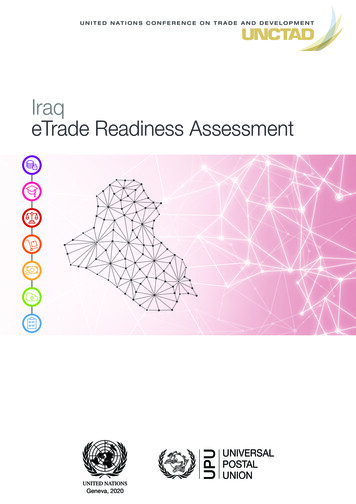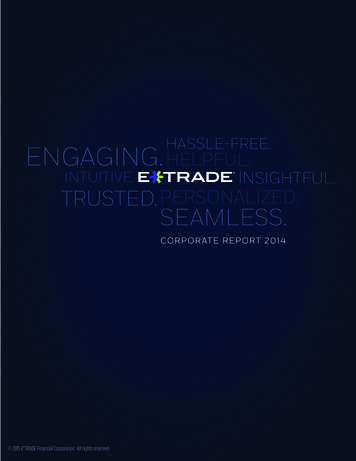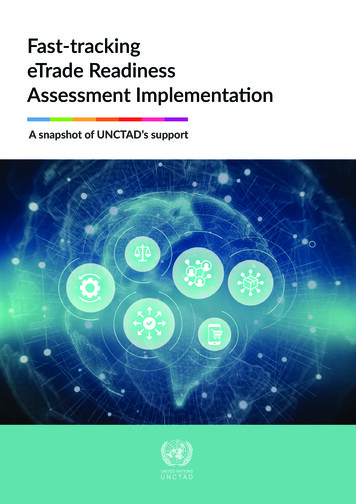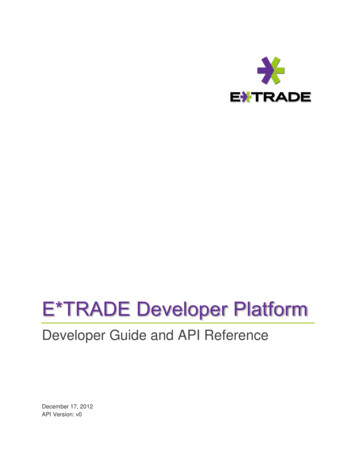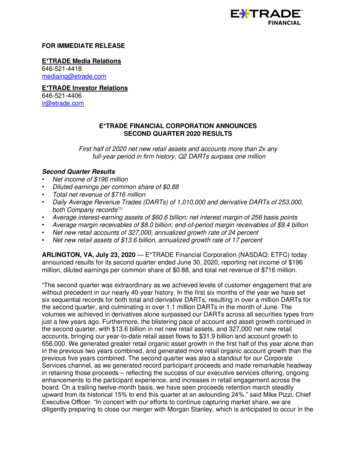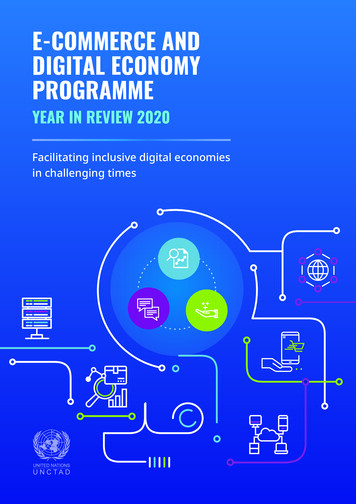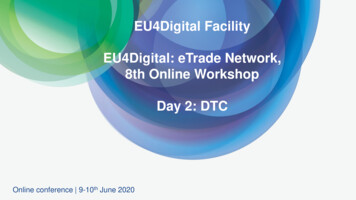
Transcription
EU4Digital FacilityEU4Digital: eTrade Network,8th Online WorkshopDay 2: DTCOnline conference 9-10th June 2020
This document provides a summary of preparatory actions for DTC implementation betweenthe Baltic Sea and the Black Sea. It summarises the draft report ‘Preparatory Actions to pilota Digital Multi-modal Transport Corridor between the Baltic Sea and the Black Sea’(submitted as a separate document).The approach is being aligned with national stakeholders in Belarus and Ukraine as well asEuropean Commission representatives. Expected date for finalisation – June 30, 2020.
DTC state of playEU4Digital assessed the state of play of digital transport corridor development in both EU and Eastern partner countries:1. Since 2015, EC is assisted by Digital Transport and Logistics Forum (DTLF) in the developments related to digitalisation of the transport and logistics sectorand fostering a more efficient electronic exchange of information in transport and logistics. Topics of focus - Paperless transport and Corridor freight informationsystems2. Two focus areas on EU level:a. Adoption of Regulation on electronic freight transport information (eFTI). Planned to be fully enforced by mid-2025 with 3 intervention objectives: (1)obligation for authorities to accept eFTI; (2) alignment of digitalised processes for regulatory information checks/processing; (3) interoperability of ITsystems and solutions (eFTI platforms)b. Developing, testing and validating the federated network of platforms - interconnecting existing platforms and harmonising the services they offer (digitaltransport corridors). Two supporting projects: FEDeRATED and FENIX cover digitized transport document process, planning, monitoring, border crossingservices and other areas in more than 40 living labs / pilot sites3. Eastern partner countries have varying levels of digitalisation of the key and supporting logistic documents on a national level; cooperation and alignment ofrequired information between different transport modes is not established. Therefore, national conditions for cross-border digital transport corridor need to beestablished4. The two countries of focus (in the scope of EU4Digital activity) have initiated nation-wide initiatives for eLogistics platform establishment, i.e. Belarus andUkraine. Countries plan government owned national eLogistics platforms u/
DTC conceptRecommended DTC implementation concept Established as a federated network of platforms in Eastern partner countries. It should support information exchange among participating countries while providingdifferent types of services. Firstly, focusing on developing of visibility-administrative (storing and sharing key logistics data) and visibility-physical (transportprogress, location details) services; later expanding to information, quotation/ marketplace, booking and ordering services, etc. Developed on the planned extensions of TEN-T to Eastern partner countries. The concept that EU4Digital developed for a corridor Baltic Sea – Black Seacomplements the extension of North Sea – Baltic TEN-T corridor. The concept could be adapted and implemented to complement extension of other TEN-Tcorridors in additional corridor Black Sea – Caspian Sea, involving Armenia, Azerbaijan, Georgia and Moldova. Built in accordance with EU existing requirements (DTLF, eFTI) and ongoingly adapted based on new specifications. Up to date knowledge is ensured throughEastern partner countries representatives engagement in DTLF (the format of involvement to be decided). Built on National eLogistics Systems (NeLS) as core components. NeLS are central national platforms facilitating provision of information for authorities and crossborder exchange. NeLS shall perform as eFTI platforms in the long term. Established and tested through multiple Living Labs (LL) initiated based on priority logistic documents in Eastern partner countries (data not documents to beexchanged). After Living Labs are tested (piloted) and adjusted from technical, organizational and legal perspectives, they go live and build DTC gradually. Connected with EU; no central platform development is planned in EU MSs (i.e. Lithuania), the connection is planned with existing government or private systems.Impact1. Exchange of logistics information is harmonised with EU – simplier, faster and trusted.2. Increased digital maturity in various transport modes inside Eastern partner countries and cross-border.3. Living Labs build up a consolidated solution – NeLS (fragmentation avoided).4. Tested (piloted) and later - live DTC solutions.5. Gradually created data pipeline.6. Stronger collaboration and networking between different logistics stakeholders in Eastern partner countries (preparation organisationally).
List of DTC Living LabsThe list of Living Labs provided below was developed taking into consideration the state of play analysis and country workshops in Belarus, Ukraine and Lithuania,interviews with state organizations and business stakeholders and eTrade network workshops involving all Eastern partner countries. The suggested list of LivingLabs is considered to be firstly applied in Baltic Sea – Black Sea corridor between Ukraine, Belarus and Lithuania to complement the North Sea – Baltic corridor ofTEN-T.Living LabDescriptionLL 1.1 National eLogisticsSystemNational eLogistics System is a centralized solution for information exchange between private and public entities on a national level aswell as cross-border. It provides a single point of truth, enabling entities to submit regulatory information electronically and authorities toaccess it electronically on a single platform. In LL 1.1, only necessary parties shall be connected and basic modules of NeLS shall bedeveloped to facilitate exchange of information foreseen in LLs 1.2 - 1.5. These modules are related to information security,authorization, data exchange and storage. NeLS implementation is gradual – results of LLs 1.1-1.5 shall be expanded later to connectwider range of public and private institutions.LL 1.2 Cross-border eCMRdata exchangeThis Living Lab involves the submission and cross-border exchange / access of electronic consignment note (eCMR) as a legaldocument between exporter, importer, carrier and interested government authorities. The exchange is performed via NeLS.LL 1.3 eSMGS/eCIM astransit declarationThis Living Lab involves submission and cross-border exchange of rail consignment note (eSMGS, eCIM or eSMGS/CIM) betweenrailway operators and customs where rail consignment note is acknowledged as transit declaration. The type of consignment note(eSMGS/ eCIM/ joint) that will be used a transit declaration is to be clarified at the inception of the Living Lab. The exchange isperformed via NeLS.LL 1.4 Cross-border eCOdata exchangeThis Living Lab involves submission and cross-border exchange / access of Electronic Certificate of Origin (eCO) between exporter,importer and customs office. eCO can be provided digitally through electronic application, that is completed using digital stamps andelectronic signatures of authorized officials, instead of physical document application. The exchange is performed via NeLS.LL 1.5 Cross-border eTIRdata exchangeThis Living Lab involves cross-border exchange of eTIR guarantees between exporter, importer and customs office. The exchange isperformed via NeLS.LL 2.1 Usage of trackingdata for faster bordercrossingThis Living Lab involves usage of tracking data by customs offices to facilitate faster border crossing. Customs office can assess inadvance the documents and information needed for a vehicle check by information available in advance in tracking system: estimatedtime of arrival, the route taken, was the container/door of consignment opened during transportation, etc. Customs officers can alsoreview the logistic documents attached in advance and only check their originality upon vehicle arrival.
DTC High-level implementation approachPhasesExisting base for DTC in Eastern partner countriesComponentsDevelopments in EUPhase 1Establishment of DTC Living Labs2021 – 2022Phase 3Harmonization with eFTI2023 (second half) – 2025Phase 2Development of DTC2022 – 2023 (second half)Component no.1Visibility-administrative processes. It includes establishment of NeLS and Living Labs facilitating exchange of different sets of data for differentmodes, including eCMR, eSMGS/CIM, eCertificate of Origin and eTIRComponent no.2Visibility-physical processes. It includes usage of tracking information for faster border crossingComponent no.3Harmonisation with EUCountry A – DTCimplementationExchangeCountry B – DTCimplementation
DTC Implementation approachPhase 1 – Establishment of DTC LivingLabsComponent no. 1: Visibility-administrative processesPhase 1 begins with the establishment of NeLS (LL 1.1) andimplementation of cross-border eCMR data exchange (LL 1.2).Existing platforms shall be used to build up NeLS (currentlyobserved in Ukraine and Belarus).NeLS core functionalities and modules are developed fortesting Living Labs between two EaP countries as well as withEU. NeLS shall be adjusted during phase 1 to function as fullsolution in phase 2.Phase 2 – Development of DTCComponent no. 1: Visibility-administrativeprocessesDuring phase 2, NeLS (including LL 1.2) is adjustedfor cross-border exchange of eSMGS/eCIM, eCOand eTIR data (LL 1.3-1.5) and to adhere anyregulatory changes and EU developments.DTC is continued to be developed by: Development of LL 1.3: eSMGS/eCIM as transitdeclarationAfter phase 1, the specification for LLs (LL 1.3-1.5) isprepared, NeLS assessment performed (compliance with EUrequirements, functionalities that need to be introduced for newLLs, etc.) and recommendations for national regulations areprovided to facilitate legal acceptance of exchanged electronicdata via NeLS. Development of LL 1.4 Cross-border eCO dataexchangeComponent no. 2: Visibility-physical processesComponent no. 2: Visibility-physical processesIn parallel to NeLS development and eCMR data exchange, aseparate solution for Usage of tracking data for faster bordercrossing is developed (LL 2.1). Development of LL 1.5 Cross-border eTIR dataexchangeEvery Living Lab is tested & adjusted during phase 2.Phase 3 – Harmonisationwith eFTITo facilitate future interoperability ofsystems in Eastern partner countriesand EU Member States, the evaluationof released eFTI requirements andspecifications is done during phase 3.Gap analysis is performed and requiredtechnical, organisational and legaladjustments of NeLS and Living Labsare made.To facilitate cross-border exchange withEU countries, NeLS would also take onthe functions of eFTI platforms after alleFTI specifications are released.In order to minimize any changesneeded, NeLS and Living Labs shall becontinuously developed according toDTLF & eFTI as per Component no. 3.The results of LL 2.1 are evaluated and adjusted. Ifconsidered successful, tracking data is used forfaster border crossing as live solution.Component no. 3: Harmonisation with EUDuring all phases of DTC implementation, representatives of Eastern partner countries participate in DTLF sessions and public events to be informed aboutdevelopments in EU and facilitate harmonisation in Eastern Partnership.EaP country representatives shall observe developments of DTLF, FEDeRATED and FENIX network to develop and adjust NeLS accordingly during all phases.Connections could be established and site visits organized through EU4Digital networking activities.
Indicative Roadmap of DTC Implementation2020 H22021 H12021 H2Developments in EUDTLFeFTI (present – 2028)FEDeRATED (present – December 2023)FENIX (present – September 2022)Existing base forDTC in Easternpartner countriesDevelopments inUkraine – NationalCentral Data BaseDevelopments inBelarus – NationalLogistics PlatformPhase 1Establishment of DTC Living Labs2023 H12022 H22022 H1Release of eFTI commondata set specifications andrequirements for MSeFTI platform &service providersrequirements2024-20252023 H2Certification rules foreFTI platform &service providerseFTI application startdate in 2024 and fullapplication in 2025Phase 3Harmonisation with eFTIPhase 2Development of DTCComponent no. 1: Visibility-administrative processesLL 1.1 – National eLogistics System (development;9 months)LL 1.1 (adjustments; ongoing)LL 1.2 – Cross-border eCMR data exchange(development; 9 months)LL 1.2 (adjustments; ongoing)Decision regarding otherLiving Labs to beintroduced on NeLS1. Evaluation of releasedeFTI requirements andspecificationsLL 1.3 – eSMGS/eCIM as transitdeclaration (development; 9 months)LL 1.3 (adjustments; ongoing)LL 1.4 – Cross-border eCO dataexchange (development; 9 months)LL 1.4 (adjustments; ongoing)LL 1.5 – Cross-border eTIR dataexchange (development; 9 months)LL 1.5 (adjustments; ongoing)Component no. 2: Visibility-physical processesLL 2.1. – Usage of tracking data for faster bordercrossing (development; 9 months)LL 2.1 – Usage of tracking data for faster border crossing (adjustments; ongoing)Component no. 3: Harmonisation with EU3.1 Engagement in DTLF activities & discussions3.2 Continuous Living Labs adjustments according to DTLF & eFTI developments(ongoing through all DTC implementation phases)*The start of DTC roadmap implementation is subject to financing of the activities. Developments in EU are also indicative and may change.**Platforms already being developed in the Eastern partner countries can be used as NeLS if proven to be capable and secure; during living lab functionalities necessary for eCMR should be prioritised.2. Performed gap analysisand specification ofrequired adjustments ofNeLS and Living Labsprepared3. Technical, organisationaland legal adjustments ofNeLS and Living Labs4. NeLS is prepared to becertified as eFTI platformfor the country
Thank YouEU4Digital website: https://eufordigital.eu/Newsletter: https://eufordigital.eu/?#newsletter
2. Two focus areas on EU level: a. Adoption of Regulation on electronic freight transport information (eFTI). Planned to be fully enforced by mid-2025 with 3 intervention objectives: (1) obligation for authorities to accept eFTI; (2) alignment of digitalised processes for regulatory information checks/processing; (3) interoperability of IT
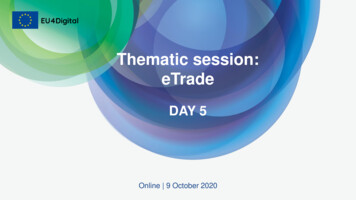
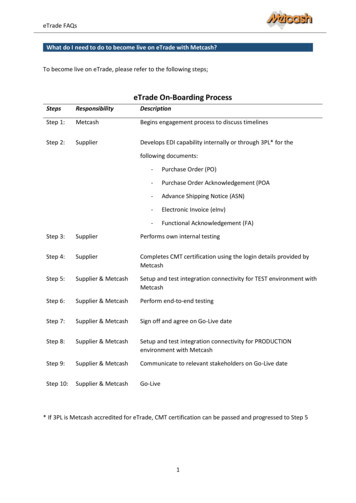
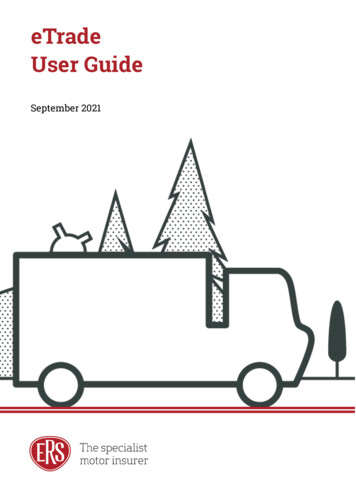
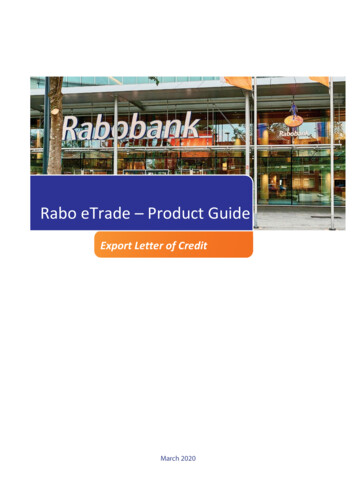
![Kenya: eTrade Readiness Assessment [ADVANCE COPY]](/img/24/dtlecdc2022d2-en.jpg)
